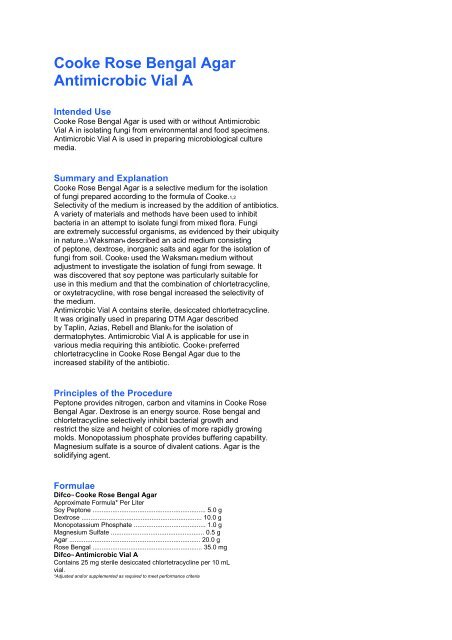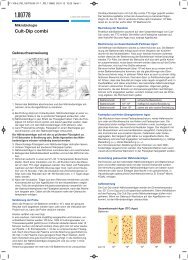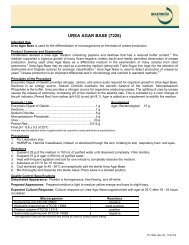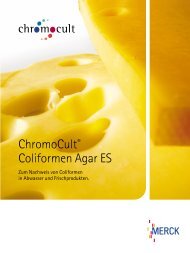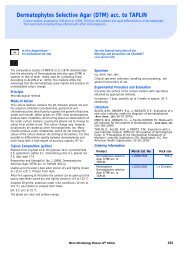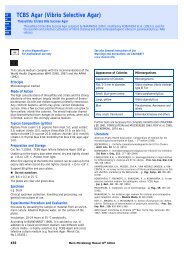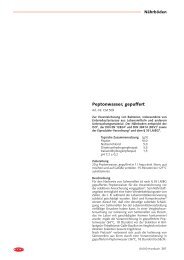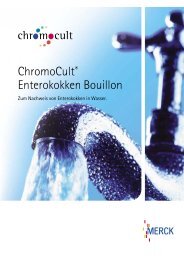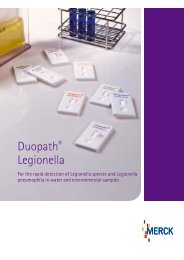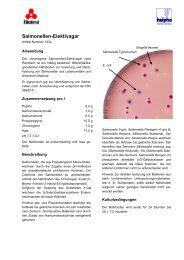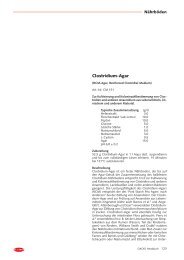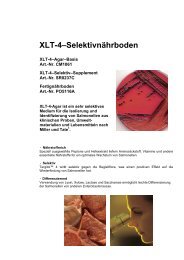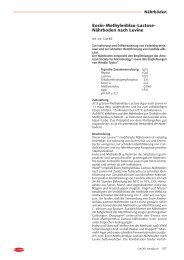Cooke Rose Bengal Agar Antimicrobic Vial A - mibius
Cooke Rose Bengal Agar Antimicrobic Vial A - mibius
Cooke Rose Bengal Agar Antimicrobic Vial A - mibius
You also want an ePaper? Increase the reach of your titles
YUMPU automatically turns print PDFs into web optimized ePapers that Google loves.
<strong>Cooke</strong> <strong>Rose</strong> <strong>Bengal</strong> <strong>Agar</strong><br />
<strong>Antimicrobic</strong> <strong>Vial</strong> A<br />
Intended Use<br />
<strong>Cooke</strong> <strong>Rose</strong> <strong>Bengal</strong> <strong>Agar</strong> is used with or without <strong>Antimicrobic</strong><br />
<strong>Vial</strong> A in isolating fungi from environmental and food specimens.<br />
<strong>Antimicrobic</strong> <strong>Vial</strong> A is used in preparing microbiological culture<br />
media.<br />
Summary and Explanation<br />
<strong>Cooke</strong> <strong>Rose</strong> <strong>Bengal</strong> <strong>Agar</strong> is a selective medium for the isolation<br />
of fungi prepared according to the formula of <strong>Cooke</strong>.1,2<br />
Selectivity of the medium is increased by the addition of antibiotics.<br />
A variety of materials and methods have been used to inhibit<br />
bacteria in an attempt to isolate fungi from mixed flora. Fungi<br />
are extremely successful organisms, as evidenced by their ubiquity<br />
in nature.3 Waksman4 described an acid medium consisting<br />
of peptone, dextrose, inorganic salts and agar for the isolation of<br />
fungi from soil. <strong>Cooke</strong>1 used the Waksman4 medium without<br />
adjustment to investigate the isolation of fungi from sewage. It<br />
was discovered that soy peptone was particularly suitable for<br />
use in this medium and that the combination of chlortetracycline,<br />
or oxytetracycline, with rose bengal increased the selectivity of<br />
the medium.<br />
<strong>Antimicrobic</strong> <strong>Vial</strong> A contains sterile, desiccated chlortetracycline.<br />
It was originally used in preparing DTM <strong>Agar</strong> described<br />
by Taplin, Azias, Rebell and Blank5 for the isolation of<br />
dermatophytes. <strong>Antimicrobic</strong> <strong>Vial</strong> A is applicable for use in<br />
various media requiring this antibiotic. <strong>Cooke</strong>1 preferred<br />
chlortetracycline in <strong>Cooke</strong> <strong>Rose</strong> <strong>Bengal</strong> <strong>Agar</strong> due to the<br />
increased stability of the antibiotic.<br />
Principles of the Procedure<br />
Peptone provides nitrogen, carbon and vitamins in <strong>Cooke</strong> <strong>Rose</strong><br />
<strong>Bengal</strong> <strong>Agar</strong>. Dextrose is an energy source. <strong>Rose</strong> bengal and<br />
chlortetracycline selectively inhibit bacterial growth and<br />
restrict the size and height of colonies of more rapidly growing<br />
molds. Monopotassium phosphate provides buffering capability.<br />
Magnesium sulfate is a source of divalent cations. <strong>Agar</strong> is the<br />
solidifying agent.<br />
Formulae<br />
Difco <strong>Cooke</strong> <strong>Rose</strong> <strong>Bengal</strong> <strong>Agar</strong><br />
Approximate Formula* Per Liter<br />
Soy Peptone ............................................................... 5.0 g<br />
Dextrose ................................................................... 10.0 g<br />
Monopotassium Phosphate ........................................ 1.0 g<br />
Magnesium Sulfate .................................................... 0.5 g<br />
<strong>Agar</strong> ......................................................................... 20.0 g<br />
<strong>Rose</strong> <strong>Bengal</strong> ............................................................. 35.0 mg<br />
Difco <strong>Antimicrobic</strong> <strong>Vial</strong> A<br />
Contains 25 mg sterile desiccated chlortetracycline per 10 mL<br />
vial.<br />
*Adjusted and/or supplemented as required to meet performance criteria
User Quality Control<br />
Identity Specifications<br />
Difco <strong>Cooke</strong> <strong>Rose</strong> <strong>Bengal</strong> <strong>Agar</strong><br />
Dehydrated Appearance: Pinkish-tan, free-flowing, homogeneous.<br />
Solution: 3.6% solution, soluble in purified water<br />
upon boiling. Solution is pinkish red,<br />
slightly opalescent.<br />
Prepared Appearance: Deep pink, slightly opalescent.<br />
Reaction of 3.6%<br />
Solution at 25°C: pH 6.0 } 0.2<br />
Difco <strong>Antimicrobic</strong> <strong>Vial</strong> A<br />
Desiccated Appearance: Yellow cake or powder.<br />
Rehydrated Appearance: Yellow, clear solution.<br />
Solution: Soluble in 10 mL purified water.<br />
Cultural Response<br />
Difco <strong>Cooke</strong> <strong>Rose</strong> <strong>Bengal</strong> <strong>Agar</strong> and <strong>Antimicrobic</strong><br />
<strong>Vial</strong> A<br />
Prepare the medium with 35 ⎧g per mL chlortetracycline (<strong>Antimicrobic</strong><br />
<strong>Vial</strong> A added aseptically) per label directions. Inoculate and incubate at<br />
25-30°C for up to 72 hours.<br />
ORGANISM ATCC INOCULUM CFU RECOVERY<br />
Aspergillus niger 16404 Undiluted Good<br />
Candida albicans 26790 30-300 Good<br />
Escherichia coli 25922 103 Inhibition<br />
Saccharomyces cerevisae 9763 30-300 Good<br />
Directions for Preparation from<br />
Dehydrated Product<br />
Difco <strong>Cooke</strong> <strong>Rose</strong> <strong>Bengal</strong> <strong>Agar</strong><br />
1. Suspend 36 g of the powder in 1 L of purified water. Mix<br />
thoroughly.<br />
2. Heat with frequent agitation and boil for 1 minute to<br />
completely dissolve the powder.<br />
3. Autoclave at 121°C for 15 minutes. Cool to 45°C.<br />
4. Aseptically add 14 mL of rehydrated <strong>Antimicrobic</strong> <strong>Vial</strong> A<br />
(final concentration of 35 ⎧g chlortetracycline per mL) or<br />
appropriate amount of another antibiotic.<br />
5. Test samples of the finished product for performance using<br />
stable, typical control cultures.<br />
Difco <strong>Antimicrobic</strong> <strong>Vial</strong> A<br />
1. Aseptically add 10 mL sterile purified water per vial of<br />
supplement.<br />
2. Agitate gently to dissolve completely.<br />
3. The resulting concentration of the rehydrated solution is<br />
2.5 mg chlortetracycline per mL.<br />
Procedure<br />
Refer to appropriate references for specific procedures on the<br />
isolation and cultivation of fungi.<br />
Expected Results<br />
Refer to appropriate references and procedures for results.<br />
Limitations of the Procedure<br />
1. Although this medium is selective primarily for fungi,<br />
microscopic examination is recommended for presumptive<br />
identification. Biochemical testing using pure cultures is<br />
required for complete identification.
2. Due to the selective properties of this medium and the type<br />
of specimen being cultured, some strains of fungi may<br />
be encountered that fail to grow or grow poorly on the<br />
complete medium; similarly, some strains of bacteria may<br />
be encountered that are not inhibited or only partially<br />
inhibited.<br />
3. Care should be taken not to expose this medium to light,<br />
since photo-degradation of rose bengal yields compounds<br />
that are toxic to fungi.6,7<br />
References<br />
1. <strong>Cooke</strong>. 1954. Antibiot. Chemother. 4:657.<br />
2. Clesceri, Greenberg and Eaton (ed.). 1998. Standard methods for the examination of water and<br />
wastewater, 20th ed. American Public Health Association, Washington, D.C.<br />
3. Dixon, Rhodes and Fromtling. 1999. In Murray, Baron, Pfaller, Tenover and Yolken (ed.), Manual<br />
of clinical microbiology, 7th ed. American Society for Microbiology, Washington, D.C.<br />
4. Waksman. 1922. J. Bacteriol. 7:339.<br />
5. Taplin, Azias, Rebell and Blank. 1969. Arch. Dermatol. 99:203.<br />
6. Banks, Board and Paton. 1985. Lett. Appl. Microbiol. 1:7.<br />
7. Beuchat and Cousin. 2001. In Downes and Ito (ed.), Compendium of methods for the microbiological<br />
examination of foods, 4th ed. American Public Health Association, Washington, D.C.<br />
Availability<br />
Difco <strong>Cooke</strong> <strong>Rose</strong> <strong>Bengal</strong> <strong>Agar</strong><br />
SMWW<br />
Cat. No. 270310 Dehydrated – 500 g<br />
Difco <strong>Antimicrobic</strong> <strong>Vial</strong> A<br />
SMWW<br />
Cat. No. 233331 <strong>Vial</strong> – 6 x 10 mL*<br />
*Store at 2-8ºC.


